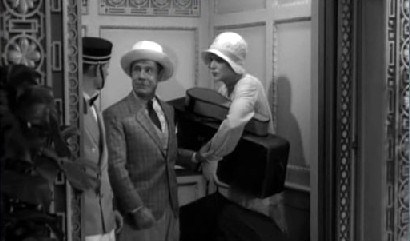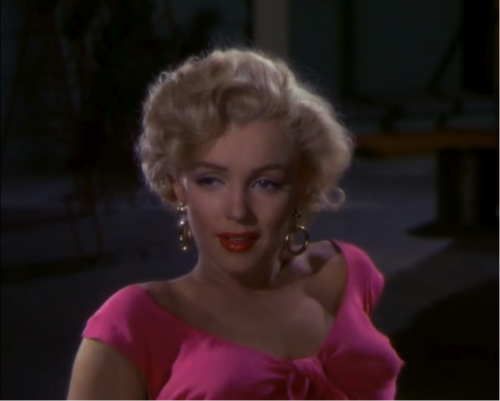This is a guest post by Brigit McCone.
Some Like It Hot topped the AFI poll as funniest film of all time, almost always ranking high in similar surveys. It is, beyond doubt, the most popular choice for the greatest cross-dressing farce of all time. While we regularly debate whether political correctness is killing comedy, it is worth remembering that the greatest cross-dressing farce is also the most humanizing (and, rather depressingly, unequaled since 1959). Where most cross-dressing comedies (except possibly those by Alice Guy) rely on the humor of insecure masculinity in a one-joke premise (“it’s funny because they think we’re gay/women, but we’re actually not gay/women, which is embarrassing because being gay/women is inferior”), Some Like It Hot expertly raises these anxieties, but has the courage to interrogate them by exploring the possible attractions of a female role. The film is still among the only cross-dressing comedies to feature a genuine gender identity crisis by a sympathetic protagonist; the human depths that this adds to the flimsy set-up are the key to its comedy. Jack Lemmon’s Daphne/Jerry is not the butt of the joke; Daphne/Jerry is an acid-tongued wit in hir own right and the film casually assumes our maturity to follow hir on hir gender journey, laughing along with its contradictions and pressures.
According to Wilder, he was unsure himself whether the legendary “nobody’s perfect” was strong enough to be the final line of the film. This suggests that Wilder was unaware of the extent to which he had crafted perfect romantic comedy between Daphne/Jerry and Osgood, along the lines of Jane Austen’s genre-defining Pride and Prejudice, which uses romance as a catalyst for confronting the self. Where Tony Curtis’ Joe and Marilyn Monroe’s Sugar Kane have a relatively flimsy romance, begun in lies and concluded with inertia as each reverts to their established type, the romance between Osgood and Daphne/Jerry is the catalyst for a psychosexual crisis as profoundly subversive as it is hilariously expressed. Although Daphne’s relationship with Osgood has been interpreted as a “low comedy flip” of the primary relationship between Curtis’s Joe and Monroe’s Sugar, I suggest that the brilliance of I. A. L. Diamond’s final line is how satisfyingly it flips that interpretation, revealing Daphne’s relationship with Osgood as the major love plot. I have explored how Austen’s template structures the psychological struggles of Fight Club; I’d now like to explore the way that it deepens and illuminates the gender identity struggle at the heart of Some Like It Hot.

The classic Pride and Prejudice meet-cute occurs when the judgmental Elizabeth Bennet is herself judgmentally dismissed by Darcy as “not handsome enough to tempt me” – its cuteness lies in the irony of the similarity at the root of the mutual hostility. The meet-cute of Some Like it Hot occurs when Osgood chivalrously leaps to restore Daphne’s lost stiletto, provoking her to comment that she is “Cinderella the Second.” The irony is double: Jerry feels the ironic absurdity of being treated as a princess when he is really a man, yet the character’s story will genuinely serve as a comic twist on the Cinderella archetype. Jerry is the downtrodden servant, constantly bullied by Tony Curtis’ alpha Joe, the wicked stepbro of macho peer pressure; Daphne is the mysterious stranger who captivates the prince. Jerry loses the coat off his back because Joe demands it; Daphne is showered with diamonds. Jerry must watch Joe get all the girls (it is significant that hir attraction to Sugar never makes Daphne/Jerry consider attempting to woo her in male form, as Joe instantly does); Daphne is a sexually irresistible “firecracker.” Daphne is swept off her feet for a night of glamorous dancing, then bullied into becoming Joe’s “Jerry” again in the morning.
The stiletto heels play a significant symbolic role in this transition. When we first see Jerry in drag, he is complaining that he doesn’t understand how women can “walk in these things.” Despite his theoretical attraction to cross-dressing (Jerry suggests cross-dressing for cash even before the pair are forced to flee the mafia, and appears titillated by the idea), he is the one who panics and feels threatened by taking on a female identity – “it’s a whole different sex!” – which for Joe is only a meaningless disguise. Where Daphne wants to choose her own name, Joe apathetically takes the feminine form of his male name. The Cinderella meet-cute with Osgood turns Daphne’s clumsy inability to walk in heels into the beginning of her fairy-tale romance, rather than a betrayal of masculinity. It is therefore a stroke of genius that the mafia recognize Daphne, at the end of the movie, because she’s still wearing her heels even when fleeing in a male disguise. Jerry is not betrayed as “really a man” while attempting to be Daphne; rather, Daphne’s true nature is revealed by her heels as she attempts unsuccessfully to pass as male. Jerry’s transition into accepting Daphne’s heels as second-nature suggests Daphne may likewise accept Osgood’s love, a conclusion as taboo in the 1950s as it was satisfying to leave to the viewer’s imagination. If the shoe fits…

In Pride and Prejudice, Elizabeth’s initial aversion to Darcy’s arrogance is compounded by a series of misunderstandings that peak in her explosive rejection of him in the famous proposal scene. In Some Like It Hot, Daphne’s loudly stated aversion to the “dirty, old man” Osgood is, from the very beginning, comically insufficient to prevent her from repeatedly flirting with him. The climax of their relationship is also a proposal scene: the sweeping of Daphne off her feet in the film’s delirious tango sequence. Daphne can’t stop leading during the dance; that might be seen as a joke reflecting her actual maleness, but it is equally a sign of her growing confidence, spark and fire. Jerry never leads with Joe or Sugar. This suggestion, that the character might be made more assertive and empowered by a female role, effectively challenges the patriarchal concept of femininity as necessarily submissive and disempowering; femininity in Some Like It Hot is portrayed as empowering and liberating when it better expresses the individual’s natural impulses and identity.
After a night of zinging banter, heady admiration and dance, Daphne is seduced and agrees to marry Osgood. In the morning, Joe forces the male role back onto her: “You’re a guy! Why would a guy want to marry a guy?” and Daphne agrees to renounce her plan. It is true that Daphne’s claim to be marrying Osgood for “security!” ironically reflects Joe and Sugar’s relationship, where Sugar believes she is chasing money and Joe believes he is chasing sex. However, rather than simply parodying their shallowness, Daphne’s shining eyes and glee after the tango scene reveal that her own attraction to Osgood is more than mercenary, just as Osgood will later reveal that his attraction to Daphne goes far deeper than a comically blind urge to chase anything in a skirt. The key to Daphne’s decision to reject Osgood’s proposal is the unquestioned assumption that Osgood would reject Jerry if he discovered his true nature; this is the underlying misunderstanding that keeps the lovers apart, forcing Daphne to define her seduction as an impractical dream. Like Cinderella’s ball, it is magical but incompatible with her real self. Where she formerly chanted “I’m a girl! I’m a girl!” to resist her sexual attraction to women, now she must chant “I’m a boy! Boy, oh boy, am I a boy!” before sighing “I wish I were dead” as she renounces her fantasy self. The use of gender identity as romantic obstacle complicates the usual dynamic of love interests rejecting each other. It is more accurate to say that Daphne rejects herself on Osgood’s behalf.

The psychological dynamics of acceptance and rejection in Pride and Prejudice are interrupted in the book’s final third by the dramatic elopement of Lydia, which brings relationships to crisis-point and a more dramatic conclusion; at first appearing to separate the lovers, it ultimately unites them. It is at roughly this same point in the plot of Some Like It Hot that the mafia re-enter. The mafia function throughout the film as a device to express transphobic anxieties without confronting them. By providing an urgent motivation for the characters’ cross-dressing, they allow the audience to avoid confronting the issue of any internal motivation. The intense, scrutinizing pressure and threat of violence which the openly transfeminine are subjected to, even today, is expressed through the extreme anxiety of the need to “pass” under mafia scrutiny, but it is not confronted: the characters of Some Like It Hot are never threatened with transphobic violence, only with murder as witnesses to the St. Valentine’s Day Massacre (although it could be regarded as symbolic that the mafia become murderous after flirting with the girls, then stripping Daphne’s curvaceous double bass to reveal her true identity – “there’s your valentine!”). Although the mafia threat appears to be a force that will drive Daphne away from Osgood, her fear of the sinister and shaming “ladies’ morgue” is ultimately the only catalyst strong enough to make her defy society’s conventions and to push her into his arms. Both the mafia and the ladies’ morgue represent exposure anxiety; they also represent an inevitable mortality before which a person’s greatest regrets are usually the things they have left undone.

The final reconciliation of Pride and Prejudice is made possible when Elizabeth Bennet sacrifices her ego to make a humiliating admission of her feelings for Darcy to Lady Catherine de Bourgh. In an even more major sacrifice, Daphne risks murder by mafia as well as humiliation by confessing her true identity to Osgood. After a series of comically escalating confessions, she finally tears away her wig and announces “I’m a man.” Osgood replies, shrugging, “nobody’s perfect.” This might be an easy laugh at Jerry’s awkward entrapment, but we have already seen his glowing eyes after their night of tango. Rather, the line “nobody’s perfect” flips our assumption that we are watching a farcical romantic parody on its head, to become supremely romantic. In a trademark Wilderism, Some Like It Hot reveals cynicism to be a facade for romance rather than the reverse: Joe and Sugar’s “real” goals of sex and money give way to their “pretended” love; Daphne and Osgood’s “real” identities as fraud and womanizer give way to their human connection. A night of chemistry at Cinderella’s ball is as real as the enforced roles of our daytime reality. The oddball coupling of a cross-dresser and a wrinkled millionaire can seem more lovable than the photogenic pairing of Monroe and Curtis. It is the genius of Lemmon’s performance that he is able to make Daphne’s personality more vivid, enticing and three-dimensional than Jerry’s, so that Daphne seems seductively like the true self that Osgood appreciated all along. Finally, a character defined for the entire film by comically escalating discomfort with their own identity meets absolute and unconditional acceptance. Our image of what happens next is a Rorschach test of each viewer’s own assumptions, of their varying levels of ageism, transphobia and romantic cynicism. But in my own interpretation, Cinderella the Second has a ball.
Brigit McCone is a shameless Wilder groupie, writes and directs short films, radio dramas and The Erotic Adventures of Vivica (as Voluptua von Temptitillatrix). Her hobbies include doodling and making weird Pride and Prejudice analogies.






